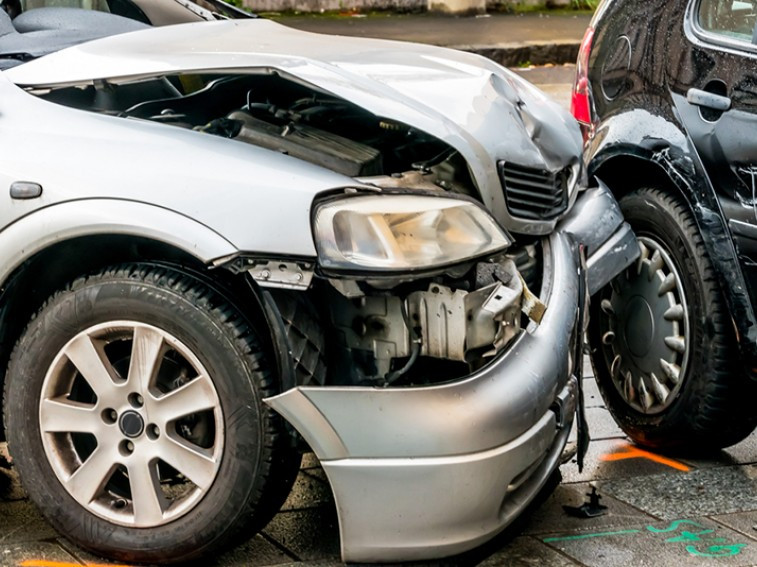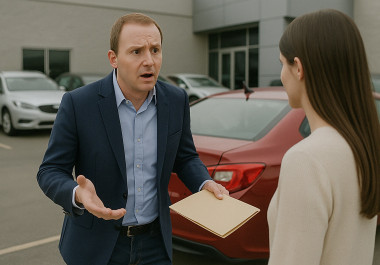A Category S car (also known as a Category C) is a vehicle that has been written off by the insurer due to structural damage. It’s one of the four salvage categories that the Association of British Insurers assign to written-off cars, in order to indicate their rough level of damage. In full, these categories are:
Category A - Scrap only. Cannot legally be returned to the road.
Category B - Salvage cars with extensive structural damage.
Category S - Significant structural damage.
Category N - Non structural damage.
Category S and Category N cars were formerly known as Category C and Category D cars respectively, before their names were changed in October 2017. Not everyone has updated their records since then, which is why you might see these vehicles referred to by their alternative salvage titles elsewhere! Here, we reveal everything you need to know about Category S salvage cars.
Why is a car classed as Category S?
When a car suffers damage, its insurer weighs up the cost of the repairs against the car’s total value. If the car costs more to fix than the insurer thinks it’s worth, then it will be declared a write-off and given an appropriate salvage category, sometimes known as a salvage title.
A car will be assigned a Category S if the type of damage that caused it to be written off is structural in nature, such as damage to its chassis. This kind of damage is normally the result of a fairly serious accident. Now, this doesn’t necessarily mean that a Category S car can never be driven again, but it can certainly make it more difficult and costly to get it roadworthy once more.
What's the difference between a Category S car and a Category N?
Simple - Category S salvage cars have been written off because of structural damage, while Category N cars have been written off due to non-structural damage. (Those initials are a handy clue!) Non-structural damage can include issues with a car’s lights, wing mirrors, infotainment system, or even cosmetic damage to its outer bodywork. On the other hand, structural damage tends to be a little more integral, and most importantly it can make the car a lot more unsafe to drive.
What is Category S damage?
Category S damage encompasses any sort of damage to the car’s frame or chassis, and typically includes things like damaged bumpers, a twisted chassis or a collapsed crumple zone, or issues with its suspension. Salvage categories are assigned by the Association of British Insurers, which officially classes structural damage as anything that requires replacing a structural part, or realigning it to its original position.
Structural damage can be anything that affects the following:
- Fire wall/front bulkhead
- Front header rail
- Front upper wing support
- Front inner wing
- Front chassis leg/welded cross member
- B-post (part of the centre pillar)
- A-post (part of the front pillar)
- Side cant rail
- Rear header rail
- Rear cross member
- Rear inner wing
- Rear wheel housing extension
- Rear chassis leg
- Sill
Why was the name changed from Category C cars to Category S cars?
Essentially, to minimise confusion and make things easier for driver to understand. Category S salvage cars were referred to as Category C cars all the way up until October 2017, at which point officials decided that they could make things more intuitive by renaming them. Renaming Category C cars to Category S cars just makes more sense, because you only have to remember that S stands for Structural. Similarly, Category D were renamed to Category N, for non-structural.
Who repairs Category S salvage cars?
Most frequently, this tends to be independent garages with specialist equipment that enables them to efficiently repair structurally damaged cars. They tend to have low overheads, as the cars can’t be sold on for the same prices as newer undamaged cars. However, when you’re getting a car repaired it’s worth remembering that their work is not legally required to be independently inspected by a separate body, so it’s something that you might have to arrange yourself.

Why won’t the insurer repair a Category S car themselves?
In short, because it doesn’t make financial sense for them. Insurers operate on cold hard numbers, and when weighing up a car for repair they’ll have to consider things like the cost of replacement parts, and labour from their insurer-approved workshops.
If it looks like they’ll ultimately make a loss on repairing the car, they won’t do it. Simple as that. (Some of the stricter insurers will only consider repairs that come to less than 50% of the car’s value.)
For drivers of course, it’s not always that straightforward. They might have all sorts of reasons they might not want their car to be written off, such as sentimental value. You can challenge your insurer’s decision to have your car taken off the roads, but be aware that it will be quite expensive to get it roadworthy again!
Is a Category S salvage car cheaper than a non-write off?
Yes. Even once a Category S car has been repaired, it’s generally seen as being riskier to insure and drive, so this is almost always reflected in a lower purchase price.
Can I drive a Category S car?
Yes, as long as it has been properly repaired and properly inspected. Once it’s been repaired, it’s a good idea to have those repairs independently inspected by a qualified mechanic can officially re-certify it with a full MOT certificate. The AA and the RAC are a few examples of organisations who offer these services. (Alternatively, you may be able to do the job alone if you’re a qualified mechanic yourself.)
Don’t forget it will also need to be fully taxed and insured before you can drive it again, and it needs to be re-registered with the DVLA before it can be taken out on public highways.
Can I insure a Category S car?
You can, as plenty of Category S cars are still perfectly driveable. However, you’ll probably find that many insurers will be reluctant to insure a Category S car, because they can’t always be 100% certain of its past and present condition. What’s more, its market value will be unclear if it’s written off for a second time. Plus, any policy you do manage to find is probably going to be significantly more expensive than you’d normally get for a new or lightly used car.
Do I have to pay more to insure a Category S car?
Yes. Even though it’s possible to insure a Category S car, it’s probably not going to be cheap. Insurance is all about risk, and unsurprisingly Category S cars are generally regarded to present a much higher risk than a brand new car - even if they’ve been repaired. Therefore, if you do plan to take a Category S car out on the roads again, brace yourself for paying much higher premiums.
What happens if I disagree with an insurer’s category S classification?
If you disagree with your insurer’s classification of your vehicle, then the good news is that you can challenge it, but you have to be prepared to put some serious work in.
To start off with, it’s worth bearing in mind that insurers base their classifications on the market value of your vehicle at the time they inspect it - so in other words, not the price you actually paid for it. However, if you still believe that your insurer has undervalued its market value when giving it a salvage category, then you can challenge their decision.
This challenge might be based on one of two reasons. The first is that you think it’s still roadworthy, and you’re seeking to convince them that it will cost no more to repair than it’s worth. The second is that you’re fine with them writing off the vehicle, but you’d like a larger settlement amount from them in return.
Either way, the first thing to do is let them know as soon as you can, or you may well find that they’ve recycled it before you have a chance to get it back. In order to prove that their price is too low, you’ll then need to search the used car market yourself to find a vehicle of comparable make, model, mileage and age, and cite this to them. Don’t forget that if your own salvage car had any new parts or accessories fitted to it at any point, those will need to be taken into consideration too.
If you’d like, you can also ask for the classification to be reviewed by an engineer who is certified with the Institute of Automotive Engineer Assessors. This won’t be cheap though, so make sure to check that all the time and money this will cost you doesn’t end up outweighing any financial rewards that you’d get for success. If the insurer still doesn’t budge, you can choose to make a final appeal by lodging a claim with the Financial Ombudsman Service, which is completely free of charge.
Do Category S cars need a VIC check?
They used to, but not anymore. Category S and Category N cars once had to undergo a Vehicle Identity Check (VIC) as standard, before they were allowed back on the roads. The idea was that this would make it more difficult for criminals to sell disguised (and dangerous) written-off cars to unsuspecting new owners. However, the scheme saw limited success, so it was closed in 2015. Now, Category S car owners just need to apply for a new V5C from the DVLA in order to get their cars back on the road.
What Category S documentation do I need?
The main document you’ll need for a Category S car is simply a new V5C or vehicle logbook, which you can get by applying to the DVLA. The new logbook will be marked with an S, and will prominently feature this phrase, exactly as worded:
This vehicle has been salvaged due to structural damage but following a technical evaluation declared suitable for repair.
This ensures that if the car is sold again, it’s easier for the new buyer to get themselves up to speed on how badly the car was damaged, and check that those repairs have been carried out to a satisfactory degree.
Do I need licences to buy a Category S vehicle?
Anyone can buy a Category S vehicle, so you don’t need any special licences as you would with something like a Category B vehicle.
Is it possible to buy a Category S without realising it?
Yes, but the likelihood of that happening depends on who you buy it from. If you’re buying from a professional dealer, the law says that it’s illegal for them to conceal important information from you. The Consumer Rights Act of 2015 offers some level of protection, as it states that any goods purchased should be of satisfactory quality, fit for purpose, and “as described”. That last one is particularly important, as there’s sometimes room for a bit of legal wiggle room in certain cases. Whatever the case, make sure to check the paperwork thoroughly, and if you’re not 100% certain on the purchase it’s a good plan to check the vehicle’s history with a company like HPI if you’re unsure.
Buying privately from another dealer is another matter entirely, as the law doesn’t apply in quite the same way. To be on the safe side, an HPI check can offer you peace of mind here, too. And in case you’re wondering, if you’re planning on buying a salvage car from one of our online vehicle auctions here at RAW2K, we recommend taking a quick look at our terms and conditions first.
Should you buy a Category S salvage car?
That really depends on what you plan to do with it. If you’re planning to drive it again, then you can save a lot of money when buying a Category S car compared to buying a brand new vehicle. However, you’ll need to be realistic about how much further investment it’ll take to get it roadworthy again. (Of course if you’re a professional mechanic, as many of our customers are here at RAW2K, you may be quite capable of saving yourself these costs by performing the work yourself anyway.)
You’ll also need to consider whether you plan on selling it on in future. If you’re buying it as your personal vehicle, its value is likely to depreciate even further. If you’re buying it to fix up and sell on, however, you may well be able to make a tidy profit in doing so - as many of our customers do!
Category S salvage cars are typically even more useful to professional mechanics and dealers, as they can be a valuable source of spare parts. If you’re buying a Category S with the intention of taking it apart eventually, then naturally the time and cost involved in getting it roadworthy again will be far less of a concern.
How to buy a Category S vehicle
It’s easy to do so right here on our site - just register, search, and start bidding! A quick word of advice - when you do find a Category S car that you’d like to buy, it’s a good idea to have it inspected by a trained motor engineer from a company such as the RAC or AA. They’ll thoroughly inspect it and bring you up to speed on every aspect of its condition and roadworthiness, including any issues that might not be immediately obvious at first glance.
It’s not cheap, but if you’re planning on putting the car back on the roads again rather than taking it apart for scrap, it can provide you with some vital peace of mind. What’s more, it can also serve as useful legal cover, as some insurers won’t insure a Category S car without seeing an engineer’s report in advance.
We’ve got a whole range of choice here at RAW2K, with our online car auctions containing models from leading brands like Ford and Vauxhall. They’re refreshed on a daily and weekly basis - so you’ll always have plenty of choice!




